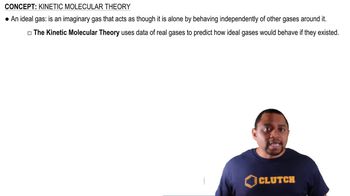Here are the essential concepts you must grasp in order to answer the question correctly.
Kinetic Molecular Theory
The Kinetic Molecular Theory explains the behavior of gases in terms of the motion of their molecules. It posits that gas molecules are in constant, random motion and that the temperature of a gas is directly proportional to the average kinetic energy of its molecules. This theory helps to understand how kinetic energy varies in solids, liquids, and gases, influencing their physical properties.
Recommended video:
Intermolecular Forces
Intermolecular forces are the attractive forces between molecules that influence the physical state of a substance. In solids, these forces are strong, keeping molecules closely packed; in liquids, they are moderate, allowing for some movement; and in gases, they are weak, resulting in free movement of molecules. Understanding these forces is crucial for comparing them to kinetic energy in different states of matter.
Recommended video:
Intermolecular vs Intramolecular Forces
Phase Changes
Phase changes refer to the transitions between solid, liquid, and gas states, which occur due to changes in temperature and pressure. During these changes, the balance between kinetic energy and intermolecular forces shifts, affecting the average energy of attraction. For instance, as a solid melts into a liquid, the kinetic energy increases, overcoming some intermolecular forces, which is essential for understanding the energy dynamics in different phases.
Recommended video:
 Verified step by step guidance
Verified step by step guidance


